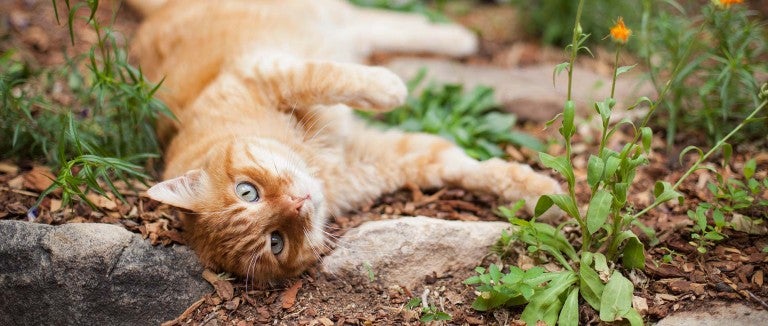If community cats are aggravating you or your pets, you should first identify who is caring for the cats and connect them with local trap-neuter-return (TNR) resources. Simply removing outdoor cats is seldom a long-term solution as more cats move into the area to take advantage of handouts from caretakers and other food sources. Sterilization is the most important step for mitigating feline nuisance behaviors and reducing the number of cats over time. And if you need a more immediate fix to your problems, check out these high-and low-tech strategies for communicating the “no trespassing” message to cats.
Motion-activated ultrasonic sound devices
These products emit a burst of ultrasonic sound (inaudible to humans) that startles cats who pass into the device’s range. A single device will deter cats from doorways to prevent territorial spraying or aggression between indoor and outdoor cats, but two or three may be needed to keep cats away from flower beds and smaller yards.
Cats can become habituated or learn to maneuver around the device’s trigger, so changing the location or adding other deterrents can improve your chances of success. (If you have dogs, you’ll need to take them into consideration when positioning the devices, as they may also be bothered by the sound.) Focus on points of entry to the off-limits area, whether it’s the yard, garden or hood of a car.
There are a variety of ultrasonic devices to choose from, including models that are friendly to birds, include strobe lights or are solar-powered. The sound waves don’t penetrate solid objects, so you needn’t worry about disturbing indoor cats or any felines on the other side of the fence.
Motion-activated sprinklers
Many TNR groups report success using motion-activated sprinklers, particularly for large yards. The device emits an infrared field covering an average backyard and is connected to a hose. When an animal the size of a cat enters the field, the device shoots out a burst of water. It doesn’t actually get the cats wet, but it does frighten them. Before long, the cats learn the boundaries of the infrared field and avoid entering it.
Some of these devices require access to a water source while others use a reservoir. You can’t use these in cold weather, since the water in the hose will freeze, but year-round use isn’t necessary—it typically takes only a few months before the cats get the message. Afterward, you can remove the device and the cats will continue to avoid the area.
Garden deterrents
You can make gardens less appealing to cats by placing small-gauge chicken wire just under the soil or using other deterrents that cats find uncomfortable to walk on. Try sharp-edged mulch or a plastic carpet runner with the knobby side up.
Scent repellents
Gardeners recommend planting a buffer of aromatic plants that cats find offensive, such as the herbs rosemary and rue or the “scaredy cat plant” (make sure any plants aren’t invasive in your area, or keep them in pots). Many TNR practitioners swear by sprinkling coffee grounds or cayenne pepper to deter cats from small areas. (Note that while products containing predator urine are advertised as effective in keeping cats away, the key ingredient is likely to be obtained by inhumane means.)
Sign up to receive our exclusive e-book full of important information about keeping your cat healthy and happy.

Another way to prevent cats from digging in gardens is to add more plants and reduce the amount of exposed soil. By covering dirt with leaves, sticks, old plant stalks and other natural materials, you will not only make it less attractive to cats, but also improve habitat for bumblebees and other ground-nesting insects and help fertilize the soil for your plants. You can also prevent cats from stalking your bird feeders.
Cat-proof fencing
Many products intended to keep cats inside yards can be used to keep cats out of locations, too. There are free-standing fencing options and products you attach to an existing fence. Many commercial cat-fencing products consist mostly of netting the cats can’t scale, but one company, Oscillot, uses rolling bars installed on top of existing fences. When cats try to scale the fence, they’ll grab onto the bar, which then spins and forces them to jump back down. (This works best in warm weather climates where there’s no risk of the rolling bars freezing in place.)
Home base improvements
Are there aspects of your property that are particularly appealing to cats? You can work with the cats’ caretakers to replicate those features in the yards where cats are welcome. This might entail providing a perch in a sunny spot, a place to get out of the rain or to find shade, or a comfortable lawn chair with a cushion.
Plant catnip as well as its showier cousin, catmint, to lure the cats to the welcome zones, and set up an outdoor litter box (with a mound of sand, dirt or soft-particle mulch). Cats also enjoy water fountains and large flower pots where they can lie down.
Mix and match
Many times, a relatively simple intervention will resolve your cat-related frustrations, while other cases will require a combination of solutions.
